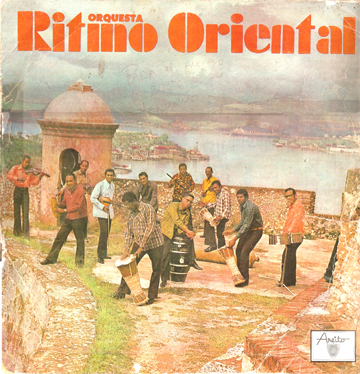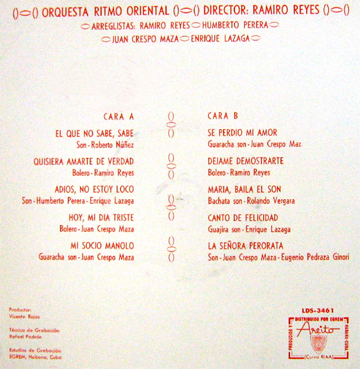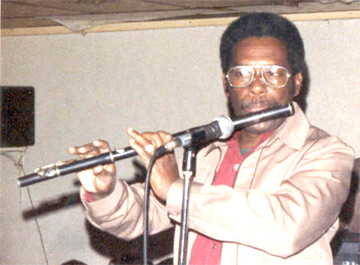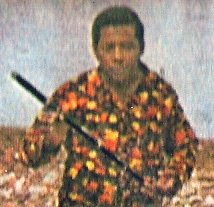Indice - Table of contents
Lo Nuevo[hide]
Reportes: From The St... : Cubadisco 2...
Fotos: Tom Ehrlich
Staff: Kristina Lim
Musicos: Juan Formell
Musicos: Yordamis Megret Planes
Musicos: Yasser Morejón Pino
Musicos: José Luis "Changuito" Quintana...
Musicos: Dennis Nicles Cobas
Fotos: Eli Silva
Grupos: Ritmo Oriental : 1988 - Vol. IX - 30 a...
Musicos: Rafael Paseiro Monzón
Musicos: Jiovanni Cofiño Sánchez
Fotos: Tom Ehrlich : 2024 Monterey Jazz, P...
Resenas: Vacilón Santiaguero (Circle 9 ...
Fotos Del Día [hide]
The Roots of Timba - Part II - Ritmo Oriental's First Album of the 70s

Areíto LD-3461 (1974) (collection of Rob Holland)

The CA-954-955 Sessions
| CA954 | El que no sabe, sabe | Roberto Núñez Povea | s | LD3461 |
| CA954 | Quisiera amarte de verdad | Ramiro Reyes | b | LD3461 |
| CA954 | Adiós, no estoy loco | Humb. Perera/Lazaga | s | LD3461 |
| CA954 | Hoy mi día triste | Juan Crespo Maza | b | LD3461 |
| CA954 | Mi socio Manolo | Juan Crespo Maza | gu-s | LD3461 |
| CA954 | Tema R.D.A. Caña | Ramiro Reyes | LD3461 | |
| CA955 | Se perdió mi amor | Juan Crespo Maza | gu-s | LD3461 |
| CA955 | Déjame demonstrate | Ramiro Reyes | b | LD3461 |
| CA955 | María baila el son | Rolando Vergara | bch-s | LD3461 |
| CA955 | Canto a la felicidad | Enrique Lazaga | gj-s | LD3461 |
| CA955 | La señora perorata | Juan Crespo Maza | s | LD3461 |
Songs in red had previously been recorded in the CA-718 sessions.
As you can see from our discography, La Ritmo's first full LP in the new style was released in 1974 between Los Van Van's second and third albums.
It was recorded in two consecutve EGREM sessions: CA-954 and CA-955. Five of the songs, (shown above in red), had already been recorded, but apparently never released, at the CA-718 session, and were covered in the previous section Now we move on to the songs that were recorded for the first time in 1974.
1974 Ritmo Oriental - El que no sabe, sabe (Roberto Núñez)
xx0x 0xxx 0xx0 xxx0 2-3 rumba clave
0x00 0xx0 x0x0 xx0x
0x00 0xx0 x0x0 x0x0 bass - MIDI
bass: Humberto Perera
source: La historia de la Ritmo, Vol. 1
notes: It took a long time for the rest of the world to catch up with Arsenio's liberating idea of extending the length of the bass tumbao beyond a single clave in length, but the idea was definitely not lost on the young Humberto Perera, who blends in some funky R&B chromaticism in the process.
This arrangement has an almost textbook example of con efecto which is easy to hear:
0x00 0xxx xxx0 0x0x
0x00 0xxx xxx0 xx0x
0x00 0xxx xxx0 0x0x
0x00 0xxx xxx0 xx0x breakdown bass tumbao
0x00 0xxx xxxx xxxx percussion and tempo stop at x
0xx0 xx0x x0xx 0x0x con efecto bloque audio
Explanation: The previous section (represented by the first 4 lines) is in Ritmo Oriental's "breakdown gear" where the piano and strings drop out. In the 5th line, the bass tumbao stops on the first back beat while the percussion continues, in time, and then stops right on the second backbeat. Then the bloque comes in at a much slower tempo. This time there's no abanico to bring the band back to full tempo - the whole rhythm section seems to be controlled by a single force!
Pop quiz: Can you spot why this example of con efecto is "almost textbook"?
Answer: The most common way to exit normal tempo and enter con efecto is for the percussion to stop on the backbeat of the 2-side. Here it stops on the backbeat of the 3-side.
1974 Ritmo Oriental - Adiós no estoy loco (Perera-Lazaga)
xx0x 0xxx 0xx0 xxx0 2-3 rumba clave
0xx0 0x0x xxx0 0000 bass - MIDI example
bass: Humberto Perera
source: La historia de la Ritmo, Vol. 1
notes: Humberto Perera was one of La Ritmo's principal arrangers but this is the first song he co-wrote. The cuerpo has abundance of creative hooks in succession, alternating between sections of dark rock and blues motivo figures and contrasting explosions of beautiful, original chord progressions, each featuring its own interesting bass figure. The fourth section of the cuerpo was borrowed almost verbatim by future la Ritmo violinist David Calzado for Charanga Habanera's Otra mujer from the 2003 Soy cubano soy popular album. It's even in the same key! CH's Sombrilla also probably borrowed his trademark interjection "Eh??" from Mi socio manolo, although I've heard it claimed (but not proven) that they both stole it from Beny Moré.
This is also one of the few Ritmo Oriental songs that has an unusual piano tumbao (or one which is prominent in the mix for that matter). After the usual breakdown to bass and percussion, the piano enters with a tumbao that mimics the rhythm of the "walking bass" we heard in Se perdio el amor. Piano tumbaos are primarily composed of offbeats, but this one has none at all (0x0x 0x0x 0x0x 0x0x).
1974 Ritmo Oriental- Tema R.D.A. (Ramiro Reyes)
xx0x 0xxx 0xx0 xxx0 2-3 rumba clave
xxx0 00x0 x0x0 xx0x bass - MIDI example
bass: Humberto Perera
source: La historia de la Ritmo, Vol. 1
notes: The opening tumbao is related melodically to the coro and also has the unusual quality (for this genre) of not hitting the downbeat. At the end of this excerpt is the transitional to a strange but beautiful section at a much slower tempo. The transition back to speed at the beginning of our second excerpt leads to the first section we've encountered from any our three bands that's based on the bombo-ponche bass tumbao (xxx0 xx0x). The chord progression, I - IV - V - IV, is the most common in Latin music -- La bamba, Guantanamera, Pare cochero ... on and on. One could say that I - IV - V - IV is to Latin music what the 12-bar blues is to North American music. Humberto improvises all around it, showing a mastery of a style which he almost never used with la Ritmo (at least at this early point). The 70s were almost completely dominated by melodic guajeo-based bass tumbaos, and almost every track was in 2-3 clave. This changed drastically in the 80s, but remember - we're still in 1974.
 Tema R.D.A. was left off of the original LP, and released, possibly for the first time, on La historia de la Ritmo, Vol. 1. Perhaps its creation -- and omission --had something to do with politics. R.D.A. stands for República Democrática Alemania - at that time, communist East Germany. Machetero, meaning literally "one who wields a machete" could have the political connotation of the hammer and sickle while also referring to Lazaga's wicked güiro playing. If you figure it out, contact us!
Tema R.D.A. was left off of the original LP, and released, possibly for the first time, on La historia de la Ritmo, Vol. 1. Perhaps its creation -- and omission --had something to do with politics. R.D.A. stands for República Democrática Alemania - at that time, communist East Germany. Machetero, meaning literally "one who wields a machete" could have the political connotation of the hammer and sickle while also referring to Lazaga's wicked güiro playing. If you figure it out, contact us!
1974 Ritmo Oriental- María baila el son (Rolando Vergara)
xx0x 0xxx 0xx0 xxx0 2-3 rumba clave
xxx0 xx0x xxx0 xx0x bombo-ponche bass tumbao
bass: Humberto Perera
source: La historia de la Ritmo, Vol. 1
notes: The main tumbao is the second most common chord progression in Latin music -- a one chord jam with a bombo-ponche bass. Humberto stretches out, playing various combinations of the standard device of doubling the bombo (xxx0 0x0x) and doubling the ponche (xxx0 xx00), and adding all sorts of funky virtuosic fills.
Policarpo "Polo" Tamayo

Polo Tamayo - 1986 - Mexico City - photo by Victor Barrientos
I'm far from an expert on charanga, (and I'm sure I'll be hearing from readers who are), but from what I have heard, it's hard to imagine that anyone could top Ritmo Oriental's flautist, "Polo" Tamayo. Aragón's Richard Egües probably has the purest and most beautiful tone, and most elegant phrasing, but Polo's funky, humorous and quick-witted ideas complement the style of la Ritmo in the most perfect way imaginable.
 Almost all of the tracks we've studied could be used to highlight Polo's contributions, but his first solo on María baila el son is particularly interesting, recalling Charlie Parker in the way he humorously takes an old song (When the Red Red Robin Comes Bob Bob Bobbin' Along) and turns it on its ear by displacing it rhythmically.
Almost all of the tracks we've studied could be used to highlight Polo's contributions, but his first solo on María baila el son is particularly interesting, recalling Charlie Parker in the way he humorously takes an old song (When the Red Red Robin Comes Bob Bob Bobbin' Along) and turns it on its ear by displacing it rhythmically.
Polo's solo also contains an interesting section where the piano tumbao switches to all offbeats. I'm still looking for the name of Ritmo Oriental's pianist (subliminal message: write EGREM!).
The cuerpo arrangement of María baila el son creates a beautiful and mysterious mood which showcases several unusual instances of Ritmo Oriental's pattented con efecto technique:
introduction:
xxxx xxxx xxxx TxTx (percussion intro - T=tom)
xxxx xxxx xxx0 0x0x (0=bass)
0xxx xxxx xxxx 0x0x
0xxx xxxx xxxS SxBx (S=strings, 0=bass - very slight con efecto)
xxxS SxBx xxxS SxBx (heavy con efecto begins on underlined note)
xxxx xxxx xxxx VxVx (V=lead vocalist - Marí ...)
0x0x xxxx xxx0 0x0x (0=bass, in tempo)
0x0x xxxx xxx0 0xxx (con efecto begins on underlined note)
BBxB BxBB BCxC xCCC (C=coro - María baile el ...)
While it doesn't use con efecto, the transition from the cuerpo to the montuno section is the highlight of the track. The percussionists take turns alternating with the bass in filling the 3-side of each clave while the güiro keeps time, but Lazaga almost steals the show. His basic part is a variation of contracampana (0x0x 0000 x000 0x00), but listen to the way he gets in and out of an all-offbeat pattern during the fourth and fifth claves:
güiro part for transition
0x0x 0000 x000 x000
0x0x 0000 x000 x000
0x0x 0000 x000 x000
x0x0 x0x0 x0x0 x0x0
x0x0 x0x0 x0x0 x00x
0x0x 0000 x000 x000
0x0x 0000 x000 x000
0x0x 0000 x000 x00x
1974 Ritmo Oriental- La señora perorata (J. C. Maza)
xx0x 0xxx 0xx0 xxx0 2-3 rumba clave
xxxx xxxx xxx0 xx0x (bass pickups)
xxx0 xx0x xxx0 xx0x
x0x0 0x0x xxx0 xx0x bass - MIDI example
bass: Humberto Perera
source: La historia de la Ritmo, Vol. 1
notes: This is the third tumbao from this session that's based on bombo-ponche. Humberto adds a catchy figure every other time to extend the tumbao to 2 claves.
The "rapped" verse of the cuerpo predates Charanga Habanera and Manolín by about 20 years, and the overdubbed female voice (Señora perorata translates to "long-winded lady") was first utilized by CH in Quítate el disfraz (source) and later parodied outright (in drag) in Yuya la charanguera (source).In-between is a melodic chorus featuring one of Juan Crespo's Maza's most addictive hooks.





















